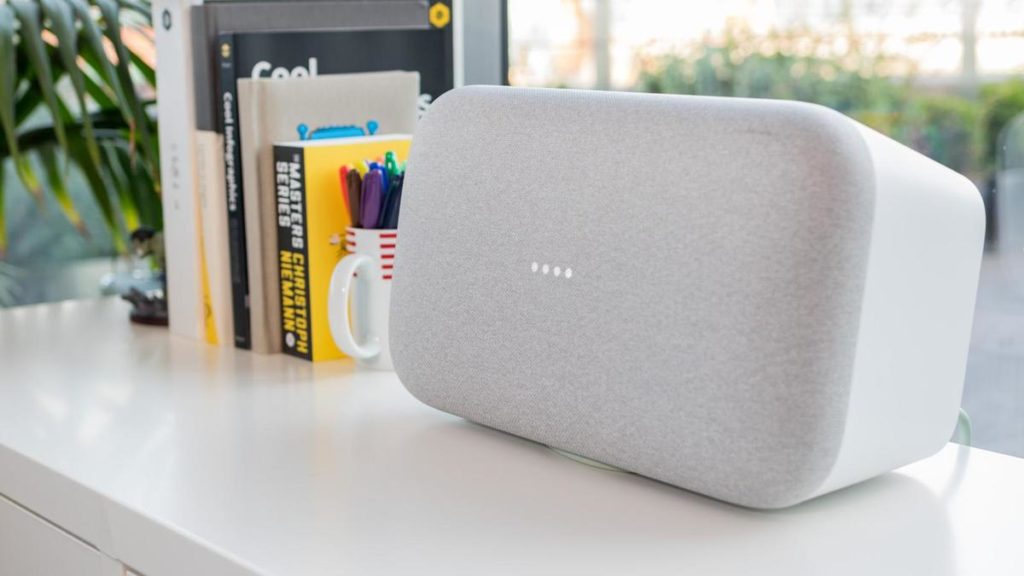GOOGLE Home Max reviews
Rating ★★★★★
Price: £399
From store.google.com
VERDICT The Google Home Max is a big beast of a smart speaker, but it’s just too pricey
So ,here we give you a brief review of Google Home Max reviews here.DESPITE BEING ANNOUNCED at the Google Pixel 2 launch last November,the Google Home Max reviews – big brother to the Home (Shopper 353) and Home Mini (Shopper 360) – has only recently landed on UK shores. It’s a much more substantial smart speaker than the rest of the range, weighing 5.3kg, but it comes with the sort of build quality you’d expect from a top-quality speaker: give it a rap with your knuckles and it feels tight, solid and totally resonance-free.
CLOTH CHIC Not everyone will love its slightly cutesy look, but the control scheme is a nice blend of minimalist design and straightforward functionality. Four circular LED dots lurk beneath the cloth grille on the front of the speaker, indicating various status indicators, lighting up when the speaker is listening to you and showing volume levels when you make adjustments. A touch-sensitive area on top of the speaker allows you to do just that by sliding your finger right and left to increase or reduce the volume and tapping the speaker to pause and play. At the rear, meanwhile, is a switch for muting the microphone and a small cutout hosting the speaker’s various connections: a calendar entries; and ask questions about the weather and various other information.
Google Home Max reviews
There’s nothing new here,so if you’re primarily concerned with smart features over audio quality, it might make more sense to buy the cheaper Home speakers. Still, Google Assistant remains excellent: it’s much better than Alexa and Siri at recognising your voice and responding to follow-up queries. Its only weak spot is that Alexa is more widely compatible with smart home kit, thanks to Amazon’s Skills feature.
ECLECTIC TASTES Google Assistant is at least much better than Siri (and on par with Alexa) when it comes to support for music and radio services. Whereas on the Apple HomePod (Shopper 364) you can only really use Apple Music if you want to search for music or podcasts by
The two4.5in woofer sand dual tweeters provide controlled, deep bass and wonderfully rich mids, all with the potential for truly awesome volume
figure-of-eight mains port, a3.5mm audio input and a USB Type-C socket. The latter is used not for audio, disappointingly, but for connecting an Ethernet adapter (which isn’t included) in case you’re having problems with Wi-Fi connectivity. The Home Max is also flexible when it
comes to connectivity. In addition to Wi-Fi, it’s also possible to play music through the speaker via 3.5mm analogue and Bluetooth. To achieve the latter, you first have to put the speaker into pairing mode via the Google Home app, which is a bit of a faff, and there’s no support for the aptX codec. The Home Max’s digital assistant features
are identical to those of the Home and Home Mini. Via Google Assistant, you can use your voice to ask the Home Max to play music and radio; set up timers, reminders and
40 voice, the Home Max allows for full voice search, control and playback via Google Play Music, Spotify (Premium and free), Deezer and YouTube Premium. Radio playback comes via TuneIn and iHeartRadio, while podcasts are played via Google’s own library. There’s no synchronisation between progress on the speaker and your phone, however, which is slightly annoying. The Home Max’s far-field microphones also
have trouble when the music is turned up; the six-mic array is fine at picking up commands with moderate background noise, but when the speaker is at 60% volume or higher we had to raise our voices far more often than with the HomePod or any of the Amazon Echo family. That’s not the only thing the Max uses its microphones for. Like the Apple HomePod,
Google Home Max uses the mics to sense its surroundings and adapt the sound output automatically. Called Smart Sound, the idea is to avoid the boomy bass caused by placing speakers close to walls and in corners, or the lean, bass-light sound you can get from a speaker in a large, open space. Sadly, unlike the HomePod, we couldn’t
notice any significant changes when moving the Home Max to different positions. The most noticeable was when we put it deep into a corner, upon which the bass became more pronounced, but that’s about it. Luckily, this is a speaker that excels at
the lower and mid-ranges, regardless of where you put it. The two 4.5in woofers and dual tweeters provide controlled, deep bass and wonderfully rich mids, all with the potential for truly awesome volume: this speaker could easily cater for an entire house party, without any distortion.
NARROWMINDED It falls short in the higher frequencies, however. This is particularly clear when playing live tracks, which lack the ideal atmosphere and presence, and the relatively slim soundstage doesn’t help. The HomePod sounds far wider and deeper, especially compared to when the Home Max is laid on its side or up on its end. These sound quality weaknesses are,it
should be said, counterbalanced by many good reasons to choose the Home Max. It’s the most flexible smart speaker on the market in terms of connectivity and supported streaming services, and Google Assistant works very effectively for the most part. However,at£399 it’s also the most expensive and doesn’t quite justify such a high price. Jonathan Bray
GOOGLE Home Max specifications
SPECIFICATIONS DRIVERS 4
•RMSPOWER OUTPUT Not stated
•DOCK CONNECTOR None
• WIRELESS Bluetooth, 802.11ac Wi-Fi
• DIMENSIONS: 190x336x154mm
•WEIGHT 5.3kg WARRANTY OneyearRTB
• DETAILS: store.google.com
•PART CODE Home Max


![Free Netflix account Id and Password March 2021[Daily Updated]](https://bloginstall.com/wp-content/uploads/2018/10/Netflix-free-150x150.jpg)
